Wolf 5 at Traveler's Rest
A Performance Work in a Sound and Sculptural Environment

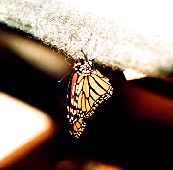
sculpture by Fernanda D'Agostino
sound installation by Dennis Báthory-Kitsz
performance work by Dennis Báthory-Kitsz
created for
a field bordering Interstate 89
Randolph, Vermont
October 12, 1991
The video and audio documents of Wolf5 have never been completed. Only raw audio and video remain, and these photographs.
Wolf5
ThePerformance and Choreographic Score (PDF format)
The Chorale (PDF format)
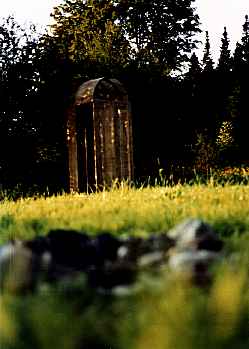
Introduction
Choreography:
- Two lines of six performers each. Toy pianos held in front. All arrive in order from perimeter/road via paths. All start sound at The Rest.
Strings:
- tacet (include accordions) (includes horn) (includes flute)
Voices:
Toy Pianos:
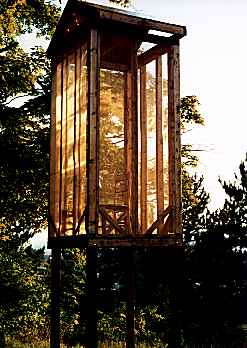
Part I
Choreography:
- Three minutes still. Voices move first, circling The Rest, making a line along the paths, and arriving at the Water House. Form a half-circle around the water house, facing outware. Pianos move second, alternating motion, along line, playing with one hand, arriving under the Stilt Chair. Make a quartet under the Stilt Chair, on benches. Strings move fast circling slowly in opposite directions around The Rest, crossing paths at the back, arriving in front, and finally entering The Rest and sitting on the benches. The main body of music begins after each section is seated.
Strings:
- Begin 3 minutes before motion, ppppp. Constate 8ve/5th (major minor) drone -- counterpoint melodic lines, optional entrances -- rhythmic figures, alternate constant, separate meters -- meters join (minimal) (tonal - not tonal - microtonal) -- effects over bridge, pizzi, col legno - tremolo - tremolo alternating with long notes -- long notes diminudendo -- silence.
Voices:
- Rocking, stacked 8ves/5ths/unisons -- free improvisation in 5ths/8ves (only) -- one person adds major 3rd -- then minor 3rd against major 3rd (root and 5th are steady) -- pause on chord (root/m3/M3/5th) -- fade -- silence.
Toy Pianos:
- While walking, bell-like C-G-C in rhythm with walk -- alternate counterpoint on notes (5ths) -- begin to rhythmicize in tonal (what else?) figures -- getting non-tonal as you can bursting into bell clusters (silences interspersed) -- install cartridges at some time (auto play) which is bridge to next part --.

Part II
Choreography:
- Violin/viola* rise and move outside of The Rest to the grass midway to the Stilt Chair. Sound begins immediately. Celli begin sound as other rise to leave. Voices walk silently away from the Water House to positions at teh turns in the path (the first midway between last turn and The Rest). Line out by turning 'round in a circle to face the receiving singer. End singers make a full turn. Toy pianos stay where they are for a few minutes, then take instruments to a line along the path, sit cross-legged on path, and play music and cards to themselves.
Strings:
- Violin/viola duet scales in Am - E - Bflat - F - C - G - Dm - A - E - Am at own pace, intertwining and legato. Celli pizzicato, opposing, in sam echord progressions (root) as other strings.
Voices:
- Line out to each other, back and forth, according to score.
Toy Pianos:
- Talking to each other while playing along with and inserting and removing cartridges Make it like a card game. Playing cards is optional. This forms bridnge to next part --
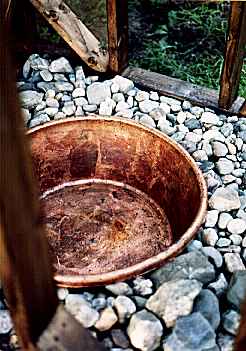
Part III
Choreography:
- Violin/viola return via a counterclockwise circle into The Rest. They make no sound, but hold each others' hands. When they return, the playing is ordinary. As the intensity rises, they wave bows and shake instruments as they play. Voices wander randomly across the site, walking and running and crawling and leaping, eventually running as quickly as possible.** Grunts begin only when all have returned to the Water House. Toy pianos circle each other, holding the instruments at head level and then aloft. The circling begins at the end of the last section, but moves quickly around the site. Grunts begin only when all have returned to the Stilt Chair.
Strings:
- Glissandi -- glissandi ending in pizzicati -- pizzicati with sudden accented stops* -- vocal whoops are added -- multiple mouth sounds and shouts with pizzicati (keep on with sudden stops, but shouts overgo) -- grab bows suddenly and make growls -- soften and get lower (physically droop over instruments) -- silence and stillness -- cello attacca to next part.
Voices:
- Howls, steady and smooth, arise in distance -- Calls -- Calls and wavering calls (loon-like) (not too loud) -- Loon calls and shouts in response to strings -- grunts and
slathering -- drape on ground -- to silence and stillness.
Toy Pianos:
- Howls arise akin to voices up to and including grunts and slathering -- at grunts, begin to shake pianos violently so they play and clatter -- drape over and with pianos in a heap on ground -- silence and stillness.
*Hard-squeezed accordion bellows, stopped horn, flute harmonic chirps.
**If men, shirts off.
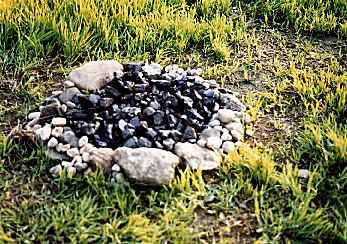
Part IV
Choreography:
-
One performer from each group moves while playing. The first motion is to circle the respective location (The Rest, Stilt Chair, or Water House) counterclockwise. One performer from each group arrives at The Rest, Stilt Chair, Water House and Fire Ring. The resulting trios form tight groups to play. In a few minutes they move their trios to the main path line between Stilt Chair and Water House. Here they form their own quartets again, one at the fire ring, one 20 feet left and the other 20 feet right. In a few more minutes they form a circle around the fire ring, circling clockwise and facing each other and the ring. The circles break up as every other person is spun out of the circle and walks up the path to the road. Two lines of six are formed this way, one line first, and then the other. They walk down the road.
Strings:
- A single call awakens with vibrato on the cello (which has in fact never stopped playing) -- melodic figure grows -- becomes a slow chorale in C (violin steady G) -- split up to other areas (no one else is playing yet) -- as strings begin move, others start to play -- chordal content, rich sound grows and rises -- move to fire ring (cell pizz on low C) -- join other parts in chorale (slowly synching).
Voices:
- Voices rise one at a time in rapid succession when strings begin to move -- split up to other areas (strings are still moving) -- join strings in same chorale at different speed -- form tight ensemble, then split up and move to fire ring -- join other parts in chorale (slowly synching).
Toy Pianos:
- After strings and voices have begun to move, start to play ostinato patterns -- split up to other areas while still playing -- join in chorale with pianos and voices while moving, forming tight ensemble -- then split up and move to fire ring, playing softer -- put pianos under arms and sing only -- join other parts in chorale (slowly synching). Or playing ocarinas.
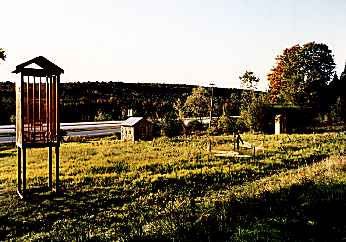
Exit
Choreography:
- Lines walk down road, out of view, and into wods. Toy pianos are held aloft in offering.
Strings:
- Keep playing the final chords of the chorale, echoing away and out of sync, ending on open 5ths. Horn call.
Voices:
- Keep singing the chorale completely and get slower until the end of it, unsynching, and leaving open 5ths.
Toy Pianos:
- Singing with other voices only.
Original Traveler’s Rest texts on tape loops, used for reading in Wolf5:
- Modified excerpt from Isaiah 40:6-7,12,30 (low sing-speak):
- The voices said, Cry. And he said, What shall I cry? All flesh is grass, and all the goodliness thereof is as the flower of the field: The grass withereth, the flower fadeth: surely the people is grass. Who hath measured the waters in the hollow of his hand, and meted out heaven with the span, and comprehended the dust of the earth in a measure, and weighed the mountains in scales, and the hills in a balance? Even the youths shall faint and be weary, and the young men shall utterly fail. The voice said, Cry. And he said, What shall I cry?
- Excerpt from The Beginning, a Zuni tale (straightforward):
- “I am a person with garden seeds,” he said. They were going to kill him. They were going to kill him, but he didn’t want it. “Very well, it’s up to you. First you must kill this, then you can kill me,” he said, and he showed them his ear of yellow corn. “There are my garden seeds. Yes, the others have come out but their only seeds are the ones they came out with. This kind of corn seed is not among them. Their flesh will not be good: That is why I have come out. But if you are going to kill me, you must kill this. Then you can kill me.” That’s what the sorcerer told them. They thought about it. When they had thought about it they did not kill him.
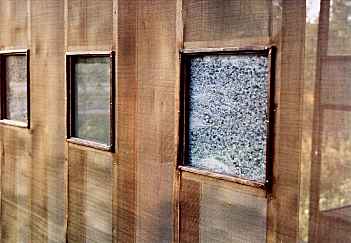
- Excerpt from What Goes Around, Comes Around, by Gay Canough and Lawrence Lehman (nasal and hectoring):
- There are over 7,000 trackable items, most in the popular low orbits (200 to 700 km). These objects are all carefully tracked (using radar) and cataloged by the US NORAD.. NORAD needs to keep track of items in orbit in order to distinguish junk from incoming enemy missiles. Unfortunately, there is so much junk for them to track, that they are working near the capacity of their systems. This means that distinguishing missiles from junk is all the more difficult. Of these 7,000 or so items, only 5% of them are working spacecraft. The smallest trackable item at 500 km is 10 cm, and at geosynchronous orbit (35785 km), the smallest trackable object is 1 meter. Notice the key word is trackable. The question that comes to mind immediately is, what about the debris we cannot track using radar? MIT scientists set out to get some idea of the population of smaller objects in orbit. Using telescopes, they could see about 8 times the number of objects tracked by radar, implying over 50,000 objects larger than 1 cm. This still does not seem like a large enough amount of junk to pollute half a trillion cubic kilometers. But consider, this situation is not at all like leaving a bunch of junk cars scattered out over somebody’s large estate. In space, debris does not stay put.
- Edited excerpt from “Visions of the Other World” in Black Elk Speaks (wondrous):
- Then we began dancing, and most of the people wailed and cried as they danced, holding hands in a circle; but some of them laughed with happiness. Now and then some one would fall down like dead, and others would go staggering around and panting before they would fall. While they were lying there like dead they were having visions, and we kept on dancing and singing, and many were crying for the old way of living and that the old religion might be with them again. After awhile I began to feel very odd. First, my legs seemed to be full of ants. (...) Suddenly it seemed that I was swinging off the ground and not touching it any longer. (...) It seemed I would glide forward like a swing, and then glide back again in longer and longer swoops. There was no fear in this (...) I must have fallen down, but I felt as though I had fallen off a swing when it was going forward (...) My body did not move at all, but I looked ahead and floated fast toward where I looked (...) I floated over the tepees and began to come down feet first at the center of the hoop where I could see a beautiful tree all green and full of flowers. When I touched the ground, two men were coming toward me, and they wore holy shirts made and painted in a certain way. They came to me and said: “It is not yet time to see your father, who is happy. You have work to do.” (...) They told me to return at once, and then I was out in the air again, floating fast as before. When I came right over the dancing place, the people were still dancing, but it seemed they were not making any sound. I had hoped to see the withered tree in bloom, but it was dead.
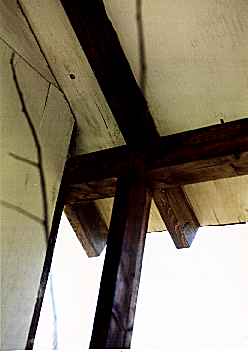
- Modified excerpt from “Accumulation of Capital” in The Wealth of Nations, by Adam Smith (silly and teacherly — sing “parsimony”):
- Parsimony, and not industry, is the immediate cause of the increase of capital. Industry, indeed, provides the subject which parsimony accumulates. But whatever industry might acquire, if parsimony did not save and store up, the capital would never be greater. Parsimony, by increasing the fund which is destined for the maintenance of productive hands, tends to increase the number of hands whose labour adds to the value of the subject upon which it is bestowed. It tends therefore to increase the exchangeable value of the annual produce. Parsimony, and not industry, is the immediate cause of the increase of capital. Parsimony, and not industry, is the immediate cause of the increase of capital. Parsimony is the immediate cause of the increase of capital. Parsimony is the cause of capital.
- Excerpt from Mouth Piece (Peace), a Dennis Báthory-Kitsz setting of Allen Ginsberg’s Rolling Thunder Stones. The text excerpt (tantric):
- Shakespeare’s Sonnet XXX (sung improvisationally and melismatically):
-
When to the sessions of sweet silent thought
I summon up remembrance of things past,
I sigh the lack of many a thing I sought,
And with the old woes new wail my dear time’s waste:
Then can I drown an eye, unused to flow,
For precious friends hid in death’s dateless night,
And weep afresh love’s long since cancell’d woe,
And moan the expense of many a vanish’d sight:
Then can I grieve at grievances foregone,
And heavily from woe to woe tell o’er
The sad account of fore-bemoaned moan,
Which I new pay as if not paid before.
But if the while I think on thee, dear friend,
All losses are restored and sorrows end.
- Dennis Báthory-Kitsz phonemic improvisation.
Lining Out (Voices, Part II)
Use the respective melodic phrase from the chorale for your voice (or another voice), up to one cadence. Note the phrase length varies (3,2,5,2,2,3,3) and only carry the lining out that far. Repeat the phrase you have heard, and line out the new phrase while turning to the next person. That person will repeat your phrase, and line out the next phrase. The lining out will continue for all four voices and seven phrases of the chorale, and repeat, beginning to overlap. At the end of this process, the voices will be singing the entire chorale, switching voices if desired. Lining out may be done as vocalise, with syllables or with text. The person(s) lining out phrases determine that.
Instrumental Phrases (Parts I, II, III)
All special effects (except where scales or chord progressions are specified) are to be performed using fragments of the chorale.
Instrumental Phrases (Part IV)
The cello improvisation is in C, and an improvisational chorale is built in C, with the violin on a steady G. As this develops and splits up and returns, it returns to the original complete chorale as written.
The Six Windows in The Rest
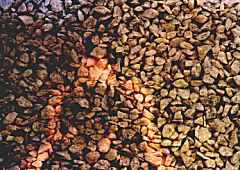
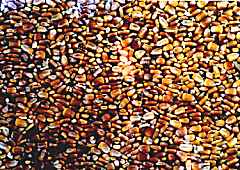
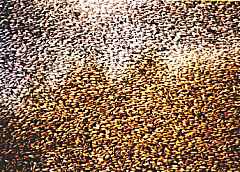
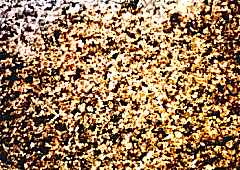
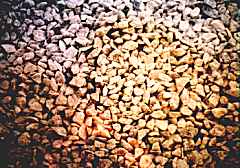
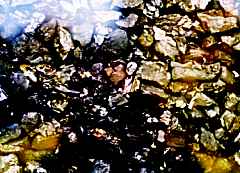
Gravel - Corn - Grain - Salt - Stone - Coal
Musical settings of chorales:
- Voices
- S, A, T, B & mixed solo doublings
- SA, ST, SB, AT, AB, TB & mixed duet doublings
- SAT, STB, ATB & mixed trio doublings
- SATB & mixed doublings
- Instruments
- horn, cello -- TB
- flute, horn -- ST, SB
- violin, cello -- SB, AB, AT
- flute, violin, cello -- SAB
- flute, 2 accordions, horn -- SATB
- violin, 2 accordions, cello -- SATB
- Mixed Voices and Instruments
- 1 voice, 2 accordions -- S/SATB
- 1 voice, 2 accordions -- T on S/SATB
- 2 voices, 2 accordions -- SA/SATB
- 2 voices, violin, cello -- AT/SB
- 2 voices, flute, horn -- AT/SB
- 4 voices, 2 accordions -- SATB/SATB
- 4 voices, flute, violin, horn, cello -- SATB/SATB
- 4 voices, all instruments
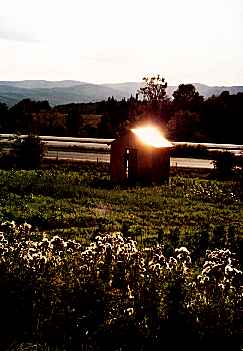
Wolf5
Music/Sound Environment Dennis Báthory-Kitsz
Choreography Dennis Báthory-Kitsz
Traveler’s Rest
Buildings and Sculptures Fernanda D'Agostino
Performers Stevie Balch - Dan Bruce
Richard Danner - Charley Freiberg
David Gunn - Susan Hydusik
Tomas Kalmar - Rip Keller
Karen Kevra - Drusilla Macey
Debra Marshall - Erik Nielsen
Gwyneth Walker
Cameras Charley Freiberg - Dennis Báthory-Kitsz
Sound Michael Smith
Editing/Mixing Michael Billingsley - Dennis Báthory-Kitsz
Construction Elwin Preston & crew - Fernanda D'Agostino
Dennis Báthory-Kitsz - Stevie Balch
Brian Foulkes
Site Bobby Gosh
Plowing Louis G. Warlick
Power Dan Sicely - Felix Thor
Equipment Paul McGowan - Dorothy Tod
Director Dennis Báthory-Kitsz
Funded by the Artists
Funded in part by the Vermont Council on the Arts "New Works" Program,
Onion River Arts Council, Fiscal Agent
Thanks to the Town and Village of Randolph, Vermont
More photos: Traveler's Rest in 2009 and 2011

Pages produced by Malted/Media















